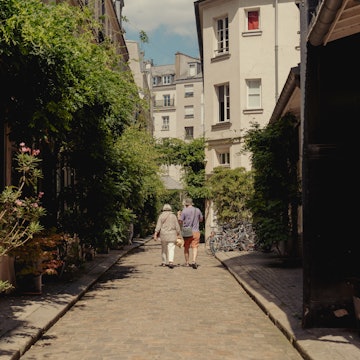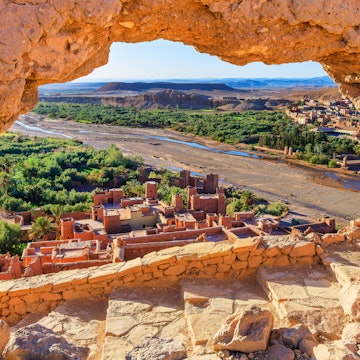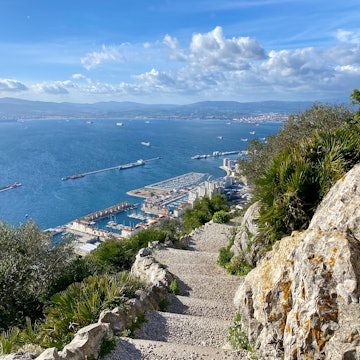

Old Town of Ciutadella, Menorca. tuulijumala/Shutterstock
One of Spain’s four main Balearic Islands, Menorca moves at its own pace – a quieter and more laid-back version of its sister islands of Mallorca and Ibiza. Take away the wild nightlife and package holiday resorts, and throw in relaxed, whitewashed villages, sheltered coves, and an emphasis on nature.
The rugged northern half of the island is characterized by craggy cliffs, odd rock formations sculpted by the Tramontana winds, and small coves of rust-colored beaches. The southern half, meanwhile, known as Migjorn, comprises limestone cliffs, punctuated by wide, bleached white-sand beaches. Explore the interior and you’ll be rewarded with a patchwork landscape of sage-green meadows, dry stone walls, and rolling hills. Sandwiching it all are the coastal cities of Ciutadella with its historic tangle of streets, and Maó (also called Mahón) with its grand port, British influences and Georgian-style architecture.
Plan your trip to Menorca with this guide for first-time visitors.

When should I go to Menorca?
Despite receiving far fewer visitors than Mallorca and Ibiza, Menorca can still get busy, particularly in the summer months of July and August. This means higher price tags, hotels booked up well in advance, and crowded beaches.
For a quieter and more relaxing trip with lower costs, consider visiting in spring or autumn. Both seasons are ideal for hiking as it’s not too hot, and in June and September, it’s usually warm enough for swimming in the sea. October and November are the wettest months, so bring waterproofs, and March and April can also see the occasional shower.
Although not a popular time to visit, winter can be a rewarding season to experience the island’s cultural offerings, particularly in the main cities of Ciutadella and Maó. Each January 17, the island celebrates the Diada del Poble de Menorca, honoring its patron saint of Sant Antoni with street fairs and entertainment across the island. Because it’s off-season though, you’ll find many tourist services closed in coastal areas and smaller villages. On the upside, you’ll have many of the hiking trails and beaches to yourself, even though it’ll be too chilly for swimming.
How much time should I spend in Menorca?
With two vibrant cultural cities, a handful of quaint villages, countless beaches and calas (coves) for swimming and exploring, you’ll want at least a week to be able to experience it properly. If you only have a few days to spare, however, the historic city of Ciutadella makes for a great base, from where you can easily access nearby rocky coves for cooling dips, check out its museums, or take the bus to visit other parts of the island. Or opt for a more traditional beach break staying in the smaller coastal towns such as Arenal d’en Castell, Son Parc and Fornells, and spend your time relaxing on the beaches. If you have a week or longer, you’ll have enough time to really get to know this compact little island, changing your base to explore different villages.

Is it easy to get in and around Menorca?
Menorca has one small airport located just 10-minutes southwest of the island’s capital of Maó, but you can also reach the island by ferry. Ferries run between Alcúdia in Mallorca to Ciutadella in Menorca, with the fastest ones taking 1–2 hours. There are also ferries running from both Barcelona (between 3–8 hours) and Valencia (15 hours).
Once on the island, it’s easy to use public transport, as bus routes crisscross the interior. Bus Illa runs between the main villages, while the Bus Platges provides transport to over 25 different beaches across the island. Be aware that some of the routes only run in summer.
Car hire and taxis are also available, but it’s worth keeping in mind that the number of rental cars on the island is limited, so you’ll need to book well in advance. For the most sustainable method of transport, consider hiring a bicycle. The island is a favorite with biking enthusiasts and there are many different routes available.

Top things to do in Menorca
Hike the Camí de Cavalls
An ancient 14th-century pathway once used by knights on horseback, this hiking route loops its way around the entire island, a 185km-trail (115-mile) that hugs the coastline. It offers some of the best views out over the Mediterranean and is one of the top ways to acquaint yourself with different parts of the island. With a total of 20 different stages, you could choose just to walk one or two during a day trip or take several days to make your way around part of the island.
Cycle to some of Menorca’s most spectacular lighthouses
Lighthouses are an iconic symbol of Menorca – elegant clifftop monuments that offer some of the most epic views across the Mediterranean. An excellent way to see them is to hire a bicycle and explore the likes of Punta Nati, Cap d’Artrutx, Cavalleria and Favaritx.
Spot wildlife in the Parque Natural de s’Albufera des Grau
Part of Menorca’s UNESCO Biosphere Reserve, Parque Natural de s’Albufera centers around a freshwater lagoon, home to numerous birdlife from cormorants and herons to fish eagles, as well as several types of lizards and tortoises. Part of the Camí de Cavalls runs through the park from Es Grau to the Cap de Favàritx lighthouse, taking around 3 hours. There are also guided tours available from the park’s Rodríguez Femenías guest center.


Seek out Menorca’s pretty beaches and calas
Menorca’s coastline is part of the very fabric of the island and its beaches are its main draws. With more than 70 dotted around the island, there’s a beach for everyone. Choose Cala en Turqueta, just southeast of Ciutadella, known for its turquoise-colored waters and striking white sand, or Cala Galdana, a crescent of sugar-like sand bordered by emerald pines. Perhaps Cala Mitjana is more your bag, a laid-back wedge of pine-fringed salt-white sand or even Cala Macarella, a sweep of blanched sand enveloped by white cliffs and lapped by an idyllic aquamarine bay.
Admire opulent architecture at Ca n’Oliver
Menorca’s center for art and history, Ca n’Oliver, houses the collection of Hernández Sanz–Hernández Mora set in an opulent 19th-century mansion in Maó. While its displays of 18th-century decorative arts, graphic works, illustrated maps and traditional furniture are exquisite, the real star is the house itself. Think Sicilian frescoes, a grand staircase decorated by wrought-iron banisters and colorful murals.
Marvel at the ancient ruins of the Talatí de Dalt talayotic settlement
Just outside Mahón lies one of the most important prehistoric settlements on the island – Talatí de Dalt – dating from the Talayotic period around 1000–700 BCE. Explore its huge stone monoliths surrounded by the ruins of ancient dwellings and caves.

My favorite thing to do in Menorca
While Menorca offers superb views from the land, I love admiring it from a different perspective on the water, and my favorite way to do this is to hire a kayak. I head to the south coast to paddle under towering limestone cliffs and seek out hidden caves, stopping every so often in a tranquil bay for a swim or a spot of snorkeling.
How much money do I need for Menorca?
Menorca is generally slightly more expensive than its sister islands of Mallorca and Ibiza, although slightly cheaper than Formentera, so you’ll need to factor that into your budget. Generally, everywhere accepts debit and credit cards, as well as other payment apps, but you will still need cash for smaller beach bars and local places away from the tourist areas, such as inland villages.
Mountain bike rental: from €25 per day (US$28.60)
Night at a beachside hotel in high season: from €200 (US$229)
Café con leche (coffee with milk) from Catedral Café in Ciutadella: €1.70 (US$1.95)
Local goats cheese salad from relaxed beach bar Xiringuito Tirant: €10.50 (US$12)
A 2-hour double kayak rental from MenorcaAventura: from €40 (US$45.75)
Lobster paella from swish restaurant Viva La Pepa: €28 per person (US$32).

How can I travel responsibly in Menorca?
Menorca may not be suffering as much from mass tourism as nearby Mallorca and Ibiza, but it’s still causing an issue due to its small size, and locals here have joined in several anti-tourism protests held across the Balearics in the last couple of years. It’s important to keep this in mind and try to lessen your impact as much as possible. Remember to be respectful and quiet in local villages, particularly in picturesque Binibeca Vella, which sees over 800,000 visitors annually, yet only has a population of 200. If you can help it, try not to rent a car – stick to public buses or hire a bicycle instead. Avoid staying in tourist apartments, which are, in part, fuelling Spain’s housing crisis by increasing rents for locals and a lack of properties on the market. If you do choose to stay in one, make sure it’s legal by checking if it has a tourist license first.
Should I tip in Menorca?
Tipping in Menorca is optional, and you won’t be expected to tip everywhere, especially if it’s just for a drink or a small snack. It’s worth noting though, that many locals working in hospitality on the island earn minimum wage, so many people choose to leave some extra change. In nicer restaurants and cocktail bars, leaving 5–10% is usual.

What words should I learn in Menorquín?
Menorquín is the local dialect of Catalan spoken in Menorca, and while many people will speak English, and of course Spanish, they’ll really appreciate it if you learn some local phrases. Begin with a greeting of bon dia (good day) and when you want to say goodbye, it’s adéu or bona nit for good night. A little gràcis (thank you) also goes a long way. Poc a poc (little by little) is also a common phrase used in Menorca due to its slow pace of life.
















